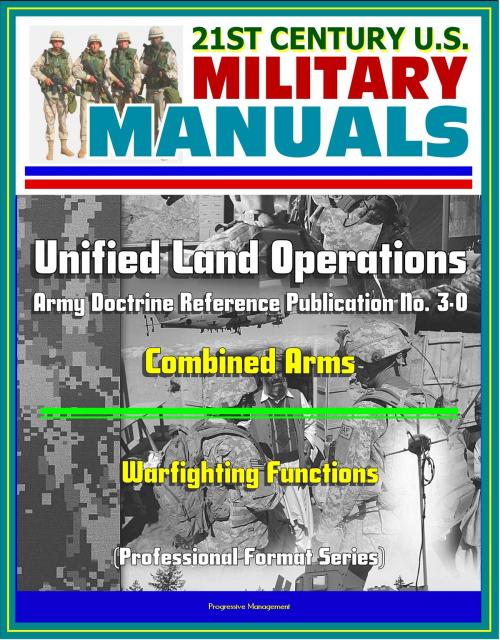21st Century U.S. Military Manuals: Unified Land Operations - Army Doctrine Reference Publication No. 3-0, ADRP 3-0, Combined Arms, Warfighting Functions (Professional Format Series)
Nonfiction, History, Military, United States| Author: | Progressive Management | ISBN: | 9781301976768 |
| Publisher: | Progressive Management | Publication: | November 28, 2012 |
| Imprint: | Smashwords Edition | Language: | English |
| Author: | Progressive Management |
| ISBN: | 9781301976768 |
| Publisher: | Progressive Management |
| Publication: | November 28, 2012 |
| Imprint: | Smashwords Edition |
| Language: | English |
Professionally converted for accurate flowing-text e-book format reproduction, this Army Field Manual is the first ADRP released under Doctrine 2015. ADRP 3-0 expands on the foundations and tenets found in Army Doctrine Publication (ADP) 3-0. This ADRP expands on the doctrine of unified land operations found in ADP 3-0. The publication of ADP 3-0 shifted the Army's operational concept from full spectrum operations to unified land operations.
ADRP 3-0 makes numerous changes from the now obsolete 2011 Field Manual (FM) 3-0, Change 1. The most significant change is the introduction of unified land operations as the Army's operational concept. The doctrine of unified land operations describes how the Army demonstrates its core competencies of combined arm maneuver and wide area security through decisive action. The term decisive action replaces the term full spectrum operations as the concept of continuous, simultaneous offense, defense, stability, or defense support of civil authorities. Defense support of civil authorities replaces civil support as a task under decisive action. ADRP 3-0 expands the discussion of the foundations and tenets of unified land operations, as well as the operational framework found in ADP 3-0.
Additional changes in ADRP 3-0 from the now obsolete 2011 FM 3-0, Change 1, includes a discussion of the range of military operations replacing the spectrum of conflict as well as a discussion of information collection replacing intelligence, reconnaissance, and surveillance (known as ISR). These changes in ADRP 3-0 now better align Army doctrine with the joint discussion of the principles of joint operations.
Contents * PREFACE * INTRODUCTION * Chapter 1 * MILITARY OPERATIONS * Unified Land Operations Defined * An Operational Environment * Unified Action * Joint Operations * Land Operations * Combined Arms * Chapter 2 * THE ARMY'S OPERATIONAL CONCEPT * Goal of Unified Land Operations * Foundations of Unified Land Operations * Tenets of Unified Land Operations * Chapter 3 * COMBAT POWER * The Elements of Combat Power * The Six Warfighting Functions * Organizing Combat Power * Chapter 4 * OPERATIONAL ART * The Application of Operational Art * The Elements of Operational Art * GLOSSARY * REFERENCES
As a bonus, this reproduction includes the complete 2012 Army Leadership manual (FM 6-22), which describes the Army's view of leadership, outlines the levels of leadership (direct, organizational, and strategic), and describes the attributes and core leader competencies across all levels.
The principal audience for ADRP 6-22 is all leaders, military and civilian. Trainers and educators throughout the Army will also use this publication. Commanders, staffs, and subordinates ensure their decisions and actions comply with applicable United States, international, and, in some cases, host-nation laws and regulations. Commanders at all levels ensure their Soldiers operate in accordance with the law of war and the rules of engagement.
Professionally converted for accurate flowing-text e-book format reproduction, this Army Field Manual is the first ADRP released under Doctrine 2015. ADRP 3-0 expands on the foundations and tenets found in Army Doctrine Publication (ADP) 3-0. This ADRP expands on the doctrine of unified land operations found in ADP 3-0. The publication of ADP 3-0 shifted the Army's operational concept from full spectrum operations to unified land operations.
ADRP 3-0 makes numerous changes from the now obsolete 2011 Field Manual (FM) 3-0, Change 1. The most significant change is the introduction of unified land operations as the Army's operational concept. The doctrine of unified land operations describes how the Army demonstrates its core competencies of combined arm maneuver and wide area security through decisive action. The term decisive action replaces the term full spectrum operations as the concept of continuous, simultaneous offense, defense, stability, or defense support of civil authorities. Defense support of civil authorities replaces civil support as a task under decisive action. ADRP 3-0 expands the discussion of the foundations and tenets of unified land operations, as well as the operational framework found in ADP 3-0.
Additional changes in ADRP 3-0 from the now obsolete 2011 FM 3-0, Change 1, includes a discussion of the range of military operations replacing the spectrum of conflict as well as a discussion of information collection replacing intelligence, reconnaissance, and surveillance (known as ISR). These changes in ADRP 3-0 now better align Army doctrine with the joint discussion of the principles of joint operations.
Contents * PREFACE * INTRODUCTION * Chapter 1 * MILITARY OPERATIONS * Unified Land Operations Defined * An Operational Environment * Unified Action * Joint Operations * Land Operations * Combined Arms * Chapter 2 * THE ARMY'S OPERATIONAL CONCEPT * Goal of Unified Land Operations * Foundations of Unified Land Operations * Tenets of Unified Land Operations * Chapter 3 * COMBAT POWER * The Elements of Combat Power * The Six Warfighting Functions * Organizing Combat Power * Chapter 4 * OPERATIONAL ART * The Application of Operational Art * The Elements of Operational Art * GLOSSARY * REFERENCES
As a bonus, this reproduction includes the complete 2012 Army Leadership manual (FM 6-22), which describes the Army's view of leadership, outlines the levels of leadership (direct, organizational, and strategic), and describes the attributes and core leader competencies across all levels.
The principal audience for ADRP 6-22 is all leaders, military and civilian. Trainers and educators throughout the Army will also use this publication. Commanders, staffs, and subordinates ensure their decisions and actions comply with applicable United States, international, and, in some cases, host-nation laws and regulations. Commanders at all levels ensure their Soldiers operate in accordance with the law of war and the rules of engagement.















